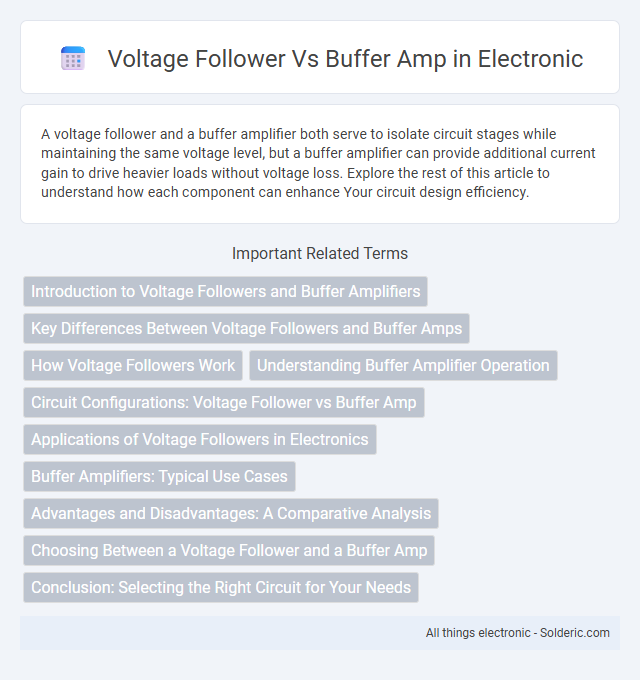A voltage follower and a buffer amplifier both serve to isolate circuit stages while maintaining the same voltage level, but a buffer amplifier can provide additional current gain to drive heavier loads without voltage loss. Explore the rest of this article to understand how each component can enhance Your circuit design efficiency.
Comparison Table
| Feature | Voltage Follower | Buffer Amplifier |
|---|---|---|
| Definition | An operational amplifier configuration providing unity gain. | An amplifier designed to isolate input from output without gain. |
| Gain | Unity (Gain = 1) | Unity (Gain = 1) |
| Purpose | Impedance matching and signal isolation. | Impedance matching, signal isolation, and driving loads. |
| Input Impedance | Very high | High to very high |
| Output Impedance | Very low | Low |
| Typical Use | Buffering sensitive signals, preventing loading effects. | Driving low impedance loads, isolating stages in circuits. |
| Circuit Configuration | Op-amp output connected directly to inverting input. | Op-amp or transistor based buffer design. |
Introduction to Voltage Followers and Buffer Amplifiers
Voltage followers and buffer amplifiers are key components in electronic circuits designed to isolate different stages without altering the signal voltage. Voltage followers provide unity gain, ensuring the output voltage precisely matches the input voltage while offering high input impedance and low output impedance. Your circuit benefits from buffer amplifiers by maintaining signal integrity and preventing loading effects in sensitive applications.
Key Differences Between Voltage Followers and Buffer Amps
Voltage followers and buffer amplifiers both provide unity gain but differ in application and internal design; voltage followers use operational amplifiers configured for high input impedance and low output impedance, ideal for impedance matching without signal amplification. Buffer amplifiers extend this concept by isolating different circuit stages to prevent loading effects while maintaining signal integrity, often incorporating additional features like improved drive capability or frequency response. Key differences lie in their typical usage contexts and performance specifications, with voltage followers primarily serving as simple impedance buffers and buffer amps tailored for specific buffering needs in complex circuits.
How Voltage Followers Work
Voltage followers, also known as buffer amplifiers, operate by providing unity gain, meaning the output voltage exactly follows the input voltage without amplification. They use an operational amplifier configured with the output directly connected to the inverting input, ensuring high input impedance and low output impedance. Your circuit benefits from voltage followers by isolating stages, preventing loading effects, and preserving signal integrity.
Understanding Buffer Amplifier Operation
A buffer amplifier, often realized as a voltage follower, provides high input impedance and low output impedance, ensuring minimal signal loss while driving heavy loads. Understanding buffer amplifier operation involves recognizing its role in isolating different circuit stages, maintaining signal voltage without amplification gain. Your circuits benefit from stable voltage transfer and improved impedance matching when using a voltage follower as a buffer amplifier.
Circuit Configurations: Voltage Follower vs Buffer Amp
Voltage followers and buffer amplifiers both serve to isolate stages without voltage gain, but their circuit configurations differ slightly. A voltage follower is typically implemented as an op-amp configured with unity gain by connecting the output directly to the inverting input, ensuring input voltage equals output voltage. In contrast, buffer amplifiers often use discrete transistor circuits or dedicated IC buffer stages designed to provide high input impedance and low output impedance, optimizing Your signal integrity in various applications.
Applications of Voltage Followers in Electronics
Voltage followers serve as ideal impedance buffers in electronic circuits, preventing signal source loading and preserving signal integrity. They are extensively used in sensor interfacing where high input impedance and low output impedance are crucial for accurate measurement. These amplifiers enable seamless signal transfer between circuit stages without voltage gain, ensuring stable voltage levels in analog signal processing.
Buffer Amplifiers: Typical Use Cases
Buffer amplifiers are commonly used to isolate different stages of a circuit, ensuring signal integrity by providing high input impedance and low output impedance. They are essential in driving heavy loads, preventing signal source loading or distortion, and maintaining voltage levels without amplification. Your electronic designs benefit from buffer amplifiers when interfacing between sensors, ADCs, or other sensitive components requiring stable and consistent voltage transfer.
Advantages and Disadvantages: A Comparative Analysis
Voltage followers provide high input impedance and low output impedance, making them ideal for impedance matching without signal amplification. Buffer amplifiers can offer both impedance matching and signal gain, but may introduce distortion and noise, impacting signal integrity. Voltage followers are simpler and consume less power, whereas buffer amplifiers provide versatility at the cost of increased complexity and potential stability issues.
Choosing Between a Voltage Follower and a Buffer Amp
Choosing between a voltage follower and a buffer amplifier depends on the application requirements such as impedance matching and signal integrity. A voltage follower, typically configured as an op-amp in unity gain mode, provides high input impedance and low output impedance, ideal for isolating stages without signal amplification. Buffer amplifiers may offer gain, driving capability, and improved drive strength, making them suitable for applications that require voltage level adjustments alongside impedance transformation.
Conclusion: Selecting the Right Circuit for Your Needs
Choosing between a voltage follower and a buffer amplifier depends on your specific circuit requirements for impedance matching and signal integrity. Voltage followers provide unity gain with high input impedance and low output impedance, ideal for isolating stages without amplification. Buffer amplifiers may offer gain control along with isolation, making them better suited when signal conditioning beyond simple impedance matching is needed for your application.
voltage follower vs buffer amp Infographic

 solderic.com
solderic.com